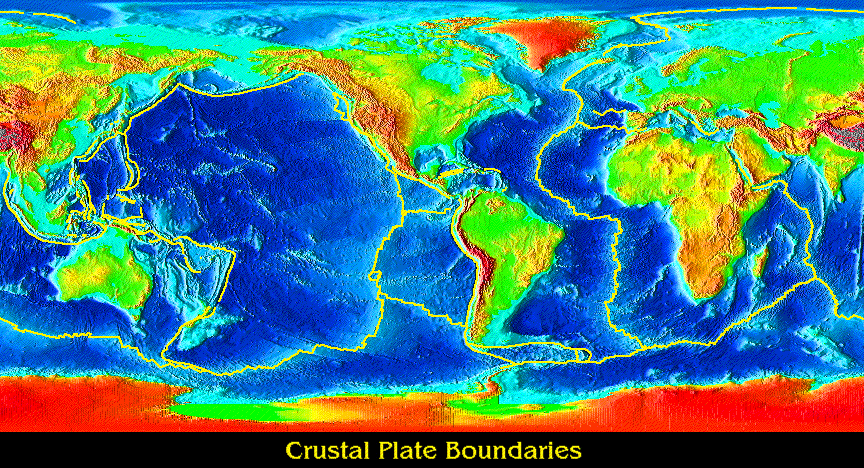MS-LS4-1
MS-ESS1-4
MS-ESS2-2
MS-ESS3-1

We really don't have a lot of "firsthand" information about the internal structure of our planet. We've only been to able directly observe a small part of our planet's crust. The rest of the layers of our planet, the mantle, outer core and inner core, have only been examined through indirect observations. When Earthquakes occur, they send vibrations, or seismic waves, through the Earth's interior. By observing carefully the behaviors of these vibrations we can get a clue as to the composition, density, state of matter and size of the various layers of the Earth.
THE CRUST: Earth's crust is primarily composed of Oxygen, Silicon, Aluminum, Iron, Calcium, Sodium, Potassium and Magnesium. It is made up of two distinct layers, the sial layer, composed of the igneous rock Granite, and the sima layer, composed of the igneous rock Basalt. Continental crust consists of both the sial and sima type crust. The crust beneath the continents averages 35 kilometers thick. The crust beneath the oceans is made up of only the sima type crust and its thickness averages only about 7 kilometers. Earth's crust is not one entire unbroken layer of rock. It is fractured in many places. The crust resembles the shell of a cracked hard-boiled egg. It is broken into about 21 different pieces, called Lithospheric Plates or crust plates. There are seven major lithospheric plates. Each of these plates moves constantly, each in its own direction. Continents ride on some of these plates, on others, oceans are carried slowly over the face of the Earth.

In the diagram above, boundaries between the plates is marked in yellow.
THE MOHOROVICIC DISCONTINUITY also called the MOHO LAYER: In 1909 a Yugoslavian scientist named Andrija Mohorovicic (Moe-hoe-row-va-cheech) discovered a previously unknown part of the Earth which was later to be named in his honor. It is a zone of transition between the Crust and the Mantle. The MOHO layer is not exactly like the Crust, nor is it exactly like the Mantle...instead, it has some properties of both.
THE MANTLE: The mantle of the Earth is composed mostly of Silicon, Oxygen, Aluminum and Iron. The temperature increases the deeper you go into the mantle. At the top the temperature is about 870 degrees Celsius, near the bottom the temperature has risen to about 2200 degrees Celsius. Geologists have been trying to drill into the mantle since the 1960's. Project Mohole and the research ship the Glomar Challenger have both attempted this task, though neither has succeeded. The mantle is approximately 2900 kilometers thick, making it Earth's largest layer. The mantle has a property called "plasticity" (where a solid has the ability to flow like a liquid). You might call the mantle "partially molten". Remember that the temperature of the mantle increases the deeper you go. This difference in temperature causes CONVECTION CURRENTS to form. This type of current forms when hot things rise and cooler things sink. These convection currents tumble throughout the mantle. They cause the Lithospheric plates floating on the mantle to move around. These currents cause our continents and oceans to change location slightly each year. The currents are the driving force for Plate Tectonics or Continental Drift, which we will discuss in more detail in a later section.
THE OUTER CORE: This layer is composed mostly of two metals, Nickel and Iron. It is approximately 2,200 kilometers thick, making it the second largest layer of our planet. The temperature of the outer core is about 5,000 degrees Celsius...that is about the same temperature as the surface of our sun! Great pressure, and possibly radioactive elements contribute to this high temperature. The Nickel and Iron of the outer core are liquid at these pressures and temperatures, making the outer core the only Liquid layer of this planet.
THE INNER CORE: The inner core is also composed of the metals Nickel and Iron. This layer is about 1,270 kilometers thick. The temperature of the inner core is estimated to be even higher than that of the outer core. It is interesting to note that this layer is a SOLID, not a liquid like the outer core, even though it is hotter than the outer core. Certainly the temperatures are high enough here to allow the molecules of this layer to be in a liquid state too! However, the intense pressure here, caused by thousands of kilometers of overlying rock, has forced the molecules back into a "solid" configuration.
The hot, dense metals of the cores, trapped in a rapidly rotating planet may be responsible for the Earth's magnetic field!